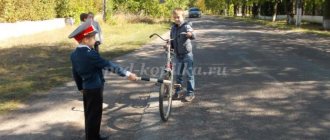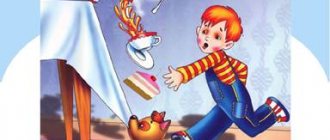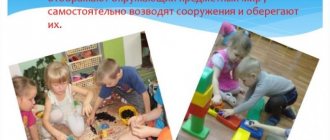Children's work in nature and its uniqueness in younger groups
PLAN
- Introduction……………………………………………………………2
- Forms of organization of work of preschool children in nature………………………………………………………….3
- Technology for supervising the work of children in younger groups……………………………………………………………4
- Recommendations for managing daily work in a corner of nature for younger groups....8
- First junior group
- Second junior group
- Conclusion………………………………………………………..….9
- List of references……………….10
Introduction
Recently, due to the growing global environmental crisis, the issue of environmental education for children has become more significant and relevant. In preschool institutions, work has intensified to develop the principles of environmental culture in children. Environmental education is part of general education. This is an important means of the comprehensive development of the child and the formation of his moral feelings. Introduce a child into the world of nature, reveal its beauty and uniqueness, teach it to love and take care of nature; To form in preschoolers a consciously correct attitude towards natural phenomena and objects, and the skills of caring for animals and plants is an important task and duty of teachers and parents.
The most favorable conditions for the active formation and manifestation of personality qualities are work in general and especially work in nature. It should bring moral pleasure to every person, both adults and children.
Starting from preschool age, every child must take part in work, and the simple duties that he performs in kindergarten and in the family must become everyday. Only under this condition does work have a certain educational effect on children and prepare them to understand its moral side.
Forms of organization of work of preschool children in nature.
The work of children in nature is organized in the form of assignments, duties, collective work, and classes are also a common form of organizing child labor in nature.
Classes are held in a corner of nature, in a vegetable garden and in a flower garden. In the process of these classes, children receive initial information about the life of plants and animals, learn what conditions are needed to grow them, acquire the necessary labor skills and abilities, which are then consolidated in everyday life.
The assimilation of knowledge and the formation of labor skills should occur not only in specially organized classes, but mainly in everyday work.
The most acceptable forms for solving educational problems are considered to be the organization of work in the form of various kinds of assignments: individual and subgroup. They can be long-term, systematic, short-term or episodic.
The instructions, according to V.G. Nechaeva and A.D. Shatova, this is the first and most accessible form of organizing child labor; it is a request from an adult addressed to a child to perform some kind of labor task. Individual assignments are used in all age groups of kindergarten, but they are of particular importance in younger groups, where work activity is just being mastered. With an individual form, the child performs the entire labor process himself. This allows the teacher to teach the child labor actions, provide assistance, monitor the performance of labor operations, evaluate activities, and take into account individual characteristics. All this helps to develop labor skills and abilities, promotes responsibility for the assigned work, perseverance, accuracy, and habits of work effort. There are also longer individual assignments for caring for a plant or animal.
Duty duties are one of the most common forms of organizing children's work in kindergarten. Duty involves children alternately performing a constant and specific range of duties. In the corner of nature, children begin to be on duty in the older group.
Collective work in nature makes it possible to develop work skills and abilities in all children in the group. Collective work unites children, develops the ability to accept a common goal of work, negotiate, jointly plan actions, coordinate them, help each other, and evaluate work. With the frontal organization of collective labor, when all children of an age group participate in the work, they can work together to perform one task, for example, weeding a garden. When cleaning a corner of nature, some wash plants, others clean animal cages, others wash trays and wipe down window sills. In this case, children are divided into subgroups.
Technology for managing the work of children in younger groups.
The mental and labor education of young children in nature is facilitated by two prerequisites: children’s desire for independence (its development) and the formation of observation skills.
The tasks of introducing children to nature and teaching labor actions can be completed at this age only with a visual and effective method of teaching. The teacher systematically imparts knowledge to the children and develops the necessary skills in them, setting mental and practical tasks for the children (what to do). By explaining and showing the material, methods of action, reveals ways to solve assigned tasks (how to do), directs children’s activities to achieve results, using demonstrations of actions; The explanation is combined with the perception, actions and speech of the children themselves. For example, when familiarizing yourself with plants, involving the child in an examination (show the stem, trace it - how long it is, and the leaves are small, the flower is round, like a ball - show the flower, smell it, etc.), the teacher helps to better understand the characteristics of this plant .
While observing animals, children are given simple tasks to care for them (sprinkle crumbs, grains for the birds on the site, feed the fish). For example, a teacher may tell a child: “You will help me feed the fish. This is food for them. Let's put him in the feeder." The teacher puts out the food himself and invites the child to do the same. The child’s cognitive activity is formed and manifested in meaningful work activity. When giving instructions, you need to take into account the characteristics of children: those with unstable attention are given simple tasks (cut vegetables for rabbits, prepare water for irrigation, see if the animals have eaten food). Children who know how to finish a job they start are given more complex tasks (sprinkle fish food with a spoon, water plants, etc.).
The teacher must organize things so that the children’s actions stimulate the necessary manifestations of a living object (for example, he offers to feed a parrot, fish, a kitten, drawing the children’s attention to their habits).
Children help the teacher in caring for animals and plants in the corner of nature and on the site. They receive individual instructions consisting of 1-2 labor operations (take ready-made bird food and put it in a feeder, water the plant with pre-prepared water, etc.) This work is short-term, but the teacher one by one involves all the children in it. In the second junior group, it is possible to organize the work of the entire group of children. Work is organized as “work nearby” - children do not experience any dependence on each other. This gives each child the opportunity to act at an individual pace, which is very important when he is just mastering skills. It is possible to organize work in small subgroups. Each subgroup performs one labor operation: wipes the leaves of a plant, or plants peas in a garden bed, or waters a flowerbed.
When teaching labor skills in nature, children of the second youngest group are shown each stage of a labor operation, while simultaneously organizing its implementation by all children. The teacher combines demonstration with explanation, and the children perform labor operations step by step. Children's work takes place with the participation of a teacher or under his supervision. The teacher helps children if they find it difficult to do something, shows them how to complete a task, and encourages those who have done the assigned work well. The teacher's assessment is always positive and has an educational orientation. Children of primary preschool age, with the help of a teacher, feed fish, birds, rabbits, water houseplants and plants in the beds.
When performing even small occasional tasks, the teacher connects them with caring for living beings: “Let’s feed the bird so that it sings”; “Let’s water this plant, otherwise the leaves will dry out.” While walking, children are taught not to pick flowers in the flower beds. Children are encouraged to take an interest in the work of growing plants and caring for animals and are taught the basic rules for doing it. It is necessary that simple things (sowing large seeds, watering plants, feeding animals, etc.) be a source of joy for children.
Children become acquainted with the inhabitants of a corner of nature throughout the year, so knowledge about their life can be more complete and more related to the feasible participation of children in caring for them. Carrying out simple tasks becomes routine. In advance, in terms of work, the teacher must outline which of the children to attract to help him, how to organize the work so that all children practice mastering the techniques. Children need to be taught to put items for caring for animals and plants in their place. Caring for animals comes down mainly to feeding them, since this work is accessible to children of the second youngest group in terms of maintenance and physical effort. The teacher explains to the children how to care for the birds: feed them grains, grass, drink clean water, teach them to pour grains into the feeder, pour fresh water into the drinking bowl and put it in the cage.
When caring for fish, children, under the supervision of a teacher, scoop up food with a spoon and carefully pour it into the feeder so as not to pollute the aquarium; can wash pebbles when changing water in the aquarium.
Teaching children how to care for plants begins with the process of watering, with children mastering the techniques of this work: correctly hold a small (but not toy) watering can, with the nose of the watering can resting on the edge of the pot. The teacher teaches the child to distinguish dry soil from wet soil (examine the soil by color and touch) and determine the need for watering. At the same time, it is important to show children that in the absence of moisture, plants (leaves, stems) lose their elasticity and droop. You need to water the plants in a thin stream until water appears on the tray. Children of this age can water plants that do not have branches at the bottom of the stem. The joint activities of children and adults here are already systematic. From time to time, the teacher brings the children together for common work on growing and caring for plants, for example, washing the leaves of a plant.
To foster a conscious attitude towards work processes, it is very important to combine work caring for plants with planting or sowing the plants themselves, playing with natural materials (sand, water, clay, snow) and giving children the opportunity to act with it in a variety of ways. When organizing children's activities, it is necessary to take into account the characteristics of the material (free-flowing sand; it can be dry and damp, you can build from raw sand; clay is viscous, strong; snow is cold, melts; in warm weather it is sticky, you can sculpt a house, a snowman, a slide from it, etc. etc.).
When there is no greenery and flowers on the site, children are especially pleased with the plants in the corner of nature that they have grown themselves, for example, the appearance of oat sprouts. This goal is common to all children: to grow green grass for our bird, so that the bird is healthy and sings happily. At the beginning of work, the teacher sets a goal for the children, shows them the grown oats, and gives the children the opportunity to feed the bird grass. Showing the results of work allows children to understand the goal and makes them want to fulfill it. Sowing can be done several times. Repeated sowings deepen children's understanding and improve their skills. Children sow on their own, each in their own box, sticking the seeds into the ground. This work is convenient because its results do not depend on the pace; children do not need to coordinate their actions with each other. At the same time, children develop the idea that a certain sequence of actions must be followed in their work. The sowing process for children consists of two parts: sticking the seeds into the ground (this technique requires a certain amount of labor effort from children, which is not the case when sowing seeds scattered) and watering. The teacher's explanation and demonstration should be brief and clear. The teacher checks the quality of the work, helps cover the seeds with soil, and waters them together with the children.
From December-January children can plant onions. It is necessary to bring to their consciousness the idea that the onions will not turn green immediately, but they must be watered every day.
Children should observe how the birds remaining for the winter (crows, sparrows) behave. Every day at a certain time, pour food onto an area cleared of snow and sprinkled with sand, a feeding table or a low-hanging feeder.
Children also participate in seasonal work on their plot. In winter, during walks, they, together with the teacher, participate in clearing the paths (sweeping away snow and transporting it on children's sleds). They explain to the children that after cleaning it will be convenient to play in the area, it will become cleaner and more beautiful. In winter, children's attention should be directed to snow-covered trees and bushes. On the site, in front of the children, you need to cover the trees with snow, explaining to them that when it gets warm, the snow will melt and the trees will be able to “drink some water.” Children of this age develop a stable interest in objects and natural phenomena, a more conscious attitude towards the work of growing plants and caring for animals as activities aimed at meeting the needs of living beings.
While caring for crops and plantings, children systematically monitor them and get used to taking the assigned task responsibly. It is necessary to gradually bring children to the understanding that for plants to live and grow, it is necessary to create favorable conditions (soil, light, heat, moisture, etc.). The teacher must help children understand the meaning of each process of work and care and develop in them the ability to see and feel the timeliness of carrying out one or another action.
Recommendations for managing daily work in a corner of nature for younger groups
First junior group
Objectives: to develop a positive attitude and skills of careful handling of them, the ability to notice the beauty and uniqueness of each living creature.
The teacher attracts the children's attention to the rules of behavior in nature, accustoms them to the idea that plants and animals, like people, need warmth, care, food, water, what they feel, how people treat them. Children are involved in simple activities that should be carried out with the help of a teacher, for example, growing green food for birds living in a corner of nature. An adult shows and explains how best to complete the task. Kids are involved in performing one-time basic tasks: politely and affectionately ask to bring a scoop, help carry a tray for molds. A correctly completed assignment evokes a feeling of pride in a child’s soul. The assignment must be really important. When caring for plants, the teacher names his actions, tells how to water the flowers, and involves the children in this.
Summary of an open show on labor education in the first junior group Topic: “Bathing the doll Katya”
Goal: to involve young children in performing simple labor actions: together with an adult and under his control (bathing the Katya doll).
Tasks: to teach children to recognize and name some labor actions (help, wash, bathe), items necessary for bathing a doll (basin, sponge, towel, soap); develop and maintain children’s interest in the work of an adult, the desire to help, and maintain cleanliness; cultivate diligence, goodwill, organization and diligence when performing assigned actions.
Required materials: Katya doll, basin, soap, sponge, large jug with warm water, a towel for the doll, small towels for children, a column with a record of “a knock on the door”, literary word: A. Barto “The Dirty Girl” (excerpt), nursery rhymes about soap and water.
Progress of the lesson:
- Organizing time:
Educator: Guys, look how many guests came to us today. Let's say hello and smile at them.
You know, I don’t see the Katya doll among our guests, she also promised to come to us, but for some reason she’s late.
(there is a knock on the door, the teacher invites the children to sit on chairs, and then goes to the door saying words)
- Main part:
Knock-knock a ringing knock is heard,
Someone is knocking on the door,
Someone is in a hurry to visit.
(the teacher opens the door and brings in the Katya doll - the doll’s nose, cheeks, and arms are smeared with black paint).
- This doll Katya came to us.
Teacher: (addresses the doll Katya)
- Oh, you dirty girl,
Where did you get your hands so dirty?
Black palms;
There are tracks on the elbows.
- Katya, what’s wrong with you? What's on your nose, cheeks, hands? What is this, children?
Children: Dirt (dirty).
Educator: Our doll got dirty. What needs to be done to make Katya clean?
Children: Wash (bathe).
Educator: Well done, we need to bathe the Katya doll.
- Educator: Now, let's help the doll Katya become clean and go bathe her (the teacher takes the doll in his hands). Guys, come to the table.
Educator: What will we bathe Katya in?
Children: In a basin (if the children find it difficult to answer, the teacher explains that this is a basin)
Teacher (turns on calm music and accompanies his words with a show) And we will wash our doll with soap and a sponge. Katya does not like to swim in cold water, she likes to swim in warm water. Touch the water carefully with your finger. It is warm (the children touch the water with their fingers).
Educator: Now I’ll take off Katya’s clothes, put her in a basin and take a sponge (takes a sponge). I’ll wet it, like this and squeeze it out a little, then lather it with soap. I’ll start washing Katya: forehead, cheeks, nose, arms, stomach, legs.
The soap will foam
And the dirt will go somewhere.
(the teacher invites the children to take turns washing the doll with a sponge; the one who helped offers to wipe their hands with a towel and sit on a chair)
Educator: Now we need to wash off all the foam from Katya (washes the doll with clean water and says affectionately)
Water, water,
Wash my face
To make your eyes sparkle,
To make your cheeks blush,
To make your mouth laugh,
So that the tooth does not bite.
(the teacher turns off the music, takes a towel, wraps the doll and wipes it well, sitting on a chair opposite the children)
Educator: Now all that remains is to wipe our doll Katya with a terry towel and dress her (dresses the doll, reciting the algorithm for putting on clothes). First we will put on her panties, then a dress, socks and shoes.
Look how clean and beautiful she has become, all the dirt has been washed away from her. Let's clap for ourselves (children clap their hands).
- Lesson summary:
Did you guys enjoy bathing the doll? (Yes.)
What did we wash it with? (Sponge, soap and water.)
What did you wipe with? (With a towel.)
Educator: Doll Katya thanks you for your help and invites you to visit her to read a book - nursery rhymes about washing. (The children and the teacher go to visit the doll Katya.)




